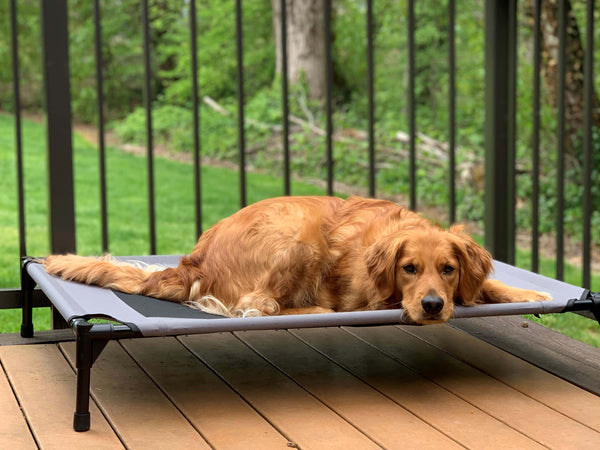
How to Teach a Dog the "Place" Command
Have you ever heard the doorbell ring and suddenly your dog went crazy and couldn't stop barking? Or did you have someone over to visit and it was tough to concentrate because your dog wanted to play? Even the friendliest dogs can benefit from learning the "place" command. With this training, your pup will go to a cot or bed whenever you need him to be quiet. Teaching the command is actually simple and fun.

The K&H Pet team wanted to speak with an expert about how to train a dog to “go to place." So we spoke with Hillary Bressler, a dog trainer in California. Bressler trained at the Michael Ellis School for Dog Trainers and now owns Walk Train Love. She offers real-world dog training, both in-person and virtually.
Teaching “place" to your dog has numerous benefits, Bressler shared.
“You can enjoy dinner with company at your home without your dog begging at the table," she said. “Or open the door without having to hold your dog back. It's good for watching a movie or doing chores while your dog is in a secure place. Your dog can learn to go to their 'place' during any situation you want him included and out of the way."
Bressler has a lot of success teaching dogs "place" using the K&H Original Pet Cot.
“I love those cots and have used them since day one," she shared. "Because the cot is elevated, it's easy for your dog to understand the 'place' behavior. Unlike a soft bed, where the dog may unknowingly be laying only partially on the bed, the K&H cot is elevated, which gives dogs a very black-and-white understanding of what it means to be 'on their bed.' The dogs love the K&H cot and find them very comfortable! The mesh in the center also keeps them cool."
In the video below, you can watch Bressler training Buddy, a Goldendoodle, on the cot.
“This is only Buddy's second session with the command, and he's rocking it," she shared.
K&H offers several varieties, including the Original Bolster Pet Cot, the Original Pet Cot, a Coolin' Pet Cot, and a Comfy Pet Cot for smaller dogs.
How to Teach Place
Here are the steps Bressler shared for teaching “place." The key for this reward-based method, she said, is taking each part in small, incremental stages with a lot of positive reinforcement.
- Encourage your dog to get on the cot by taking a big step towards the cot or holding a treat over it.
- When your dog gets on the cot, praise him and give him a treat.
- Then say “free" and release him from the bed, inviting him to leave.
- Keep doing this repeatedly until you can take a smaller step towards the cot and your dog will jump on it right away. This becomes your “gesture."
- Once your dog masters the gesture, start saying “place" first and then take a step towards the cot.
- Each time your dog gets on the cot, praise him, give him a treat, say "free," and encourage him off the cot. It's important to say "free" before you move away from or encourage your dog off the bed.
- Gradually shrink the gesture until you've eliminated it and can just say “place"—without moving—and your dog will jump on the cot. Start with a big step towards the bed and shorten your step until it's barely noticeable. Then, you can eliminate the step.
How to "Place" to a Doorbell
You don't have to stop with “place." Once your dog has mastered this cue, you can move on to your dog learning to “place" herself with specific sounds. Teaching your dog “place" this way is fairly simple once she's mastered the word.
"It's all about patterns," Bressler said. "Just repeat the steps over and over following a specific order until she picks up on it."
Start by ringing the doorbell, then say “place," and give your dog a treat when she goes to the cot. Eventually, you can drop the word “place" and start just giving her a treat when she goes to the cot after the doorbell rings.
You don't have to stop with the doorbell.
“If your dog knows 'place' with just the word, you can use other sounds too," she said.
If your dog gets overly excited when you bring out her food at mealtime, you can teach her to “place" when she hears the sound of the food bin opening. If she's scared of the vacuum cleaner, you can teach her to “place" when she hears it. There are many options for teaching "place" with different sounds.
How to Help a Dog Who Has Trouble Learning
"Place" is a fairly easy command for a dog to learn, and you usually don't need to train your dog with any other commands first, Bressler said.
"Teaching 'place' is a great behavior to start with for a dog that is new to training, because it is a simple way to show him how his actions generate rewards. And it's a great relationship and confidence-building exercise," Bressler said.
If your dog struggles with it, there are a few things you can do to help.
Many dogs are food motivated. If yours isn't, Bressler suggests you schedule training right before mealtime so he's hungry. And make sure you have your training session when his energy levels are high. Don't take him for a long jog and exercise session outside and then try to teach him “place" when he's exhausted.
You can also set him up for success by making sure each step builds on the one before it.
“Be patient," she advised. “If your dog's struggling with a part of the command, go back to the step before it."
“Place" is a great command to teach your pup. Most will take to it very quickly, but even slower learners will eventually build confidence with this simple but highly useful training tool.
